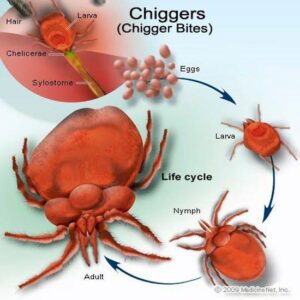I hate chiggers. These miniscule mites turn impromptu summer hikes and fishing jaunts into adventures in dermatological disaster. The little pests just LOVE me.
The other day I noticed the fish hitting the surface of our pond. Looked like an ideal time to toss a fishing line in to catch some supper! I got my pole out of the garage and trotted to the pond. Well, the fish weren’t biting, but the chiggers were in full force. My focus being on the promising fishing opportunity, I didn’t apply any of my handy-dandy DIY bug repellant. I regretted my oversight.
In the middle of the night, I was awakened by the most MADDENING itching. I wriggled and scratched, and the itching just got worse. In my sleepy stupor, it didn’t occur to me why the heck I was itching so much. But when I finally rolled out of bed and saw myself in the bathroom mirror, the culprit was obvious. I was literally covered with little red welts in all the various tender and unmentionable places. Great.
Chiggers are nasty little pests that usually lurk in tall grass, such as is around the downward slope of the dam of our pond. They are the larvae of a type of mite, but contrary to popular belief, they do not burrow under the skin and suck your blood.
These pests crawl on their host until they find a suitable site to feed. Their favorite places are the nice, tender, warm spots on your body, like the creases behind your knees, under skin folds, and along the waistband or leg bands of your pants or undergarments. Once they find a spot they like, they insert their tube-like mouthparts into the skin and inject a digesting enzyme that liquefies skin cells. Then they feed. The resulting “bites” that present as itchy, red, raised bumps or welts are an allergic reaction to the digestive solution they inject. Eeew.
Whatever the cause, chigger bites are, in my opinion, about akin to a medieval torture device.
So, I am here to give readers a few ways to get rid of the maddening itch caused by chiggers. These are specific for chigger bites, and I include several remedies to try since not everyone will respond the same to any certain remedy. I know what works best for me, but it might not work the best for you.
Remedy No. 1 Bleach Bath
I know this sounds crazy, but this one has worked great for me and most anyone I have recommended it to. My grandparents used this remedy after working in corn fields, cutting hay or working in the garden. The ingredients are quite simple: standard household bleach, warm bath water, and a large bathtub. Just add about 1/4 to 1/2 cup bleach to a full bathtub (with water enough to cover your body where the chiggers have bitten) and soak. From what I understand about this remedy, the bleach dries out the bite, kills any leftover critters, and tames the itch. It can be repeated as needed.
Remedy No. 2 Salt
This one surprised me in its effectiveness. There are a few ways to apply the salt to affected areas. The easiest is to take about 1 tablespoon Vaseline, place it in a small container, and add 1 or 2 teaspoons salt. It can be Epsom salts or regular table salt. Apply directly to the bites.
Now, obviously, this does not work well when you need to go out and about. Salt crystals inside warm, sweaty undergarments are NOT comfortable. Don’t ask how I know. So, I found another alternative. I had purchased an all-natural deodorant product several years ago at the health food store.

Since this crystal is made of a type of salt, I thought I would try it. It worked surprisingly well. The deodorant “stick” is encased in a handy plastic container, and to use it, you just wet the end and rub it on your skin. It dries quickly, has no odor, is not sticky, leaves no residue, costs less than 5 bucks and lasts almost forever. The areas I used this on didn’t itch all day.
Remedy No. 3 Ammonia
This is a common ingredient found in over-the-counter bug-bite treatments such as After Bite.
However, you can use household ammonia in the same way. Just dip a cotton-tipped applicator in the ammonia and dab on the bites. Of course, this one is kind of smelly, but the odor does not usually last long and is contained by clothing. If you have glass cleaner, such as Windex, try checking the label to see if it has ammonia. If so, that might work just as well.

Remedy No. 4 Vicks Vapo Rub
This is one I use at night, as the scent can be less than inconspicuous. Just dab on the bites and the itch goes away. This one seems to need more frequent application.
Remedy No. 5 Baking Soda or Meat Tenderizer
Mix a couple teaspoons of whichever you prefer with water and mix to make a sticky paste. Apply to the bites. This one helps with swelling and erythema (redness), but did not stop itching for a long period of time. It works great on mosquito bites and wasp stings.
Remedy No. 6 Tea Tree Oil
Now, I have not tried this one, but from what I can find out it seems to be very effective in long-lasting relief of the itching. Here’s the recipe:
1/2 teaspoon dish soap, 1/4 cup pineapple juice, 1/2 teaspoon tea tree oil
Mix these together and let them sit for a couple of minutes. Then add 1/2 teaspoon cayenne pepper. Let this mixture sit for a few more minutes. Use a cotton-tipped applicator to apply to bites. Cover with band aids if necessary to hold the paste in place.
This concoction may cause a warming sensation to your skin, and should NOT be used on small children or those with sensitive skin. In addition, don’t get this anywhere CLOSE to eyes, mouth, or mucous membranes (girls … I’m talking to you, if you catch my drift). Maybe an easier way to say it is to only apply it where the sun DOES shine. The pineapple juice and tea tree oil have enzymes that help neutralize the digestive enzymes that cause the itching, so the sooner the better in using this remedy.
Remedy No. 7 Honey
Again, I have not personally tried this one, but honey has many healing uses including powerful anti-inflammatory properties. Apply a small dab of honey (locally produced is preferred) to the pad of a band-aid and apply to bite site. This works well for other insect bites, too. However, it can be pretty messy. Use sparingly on the band-aid to avoid a sticky mess oozing out onto your clothes.
I have also heard of using clear nail polish and/or school glue to coat the bites. These remedies might work for some, but the belief that they work by smothering the chiggers is not true, since the chiggers do not burrow under the skin.
Be sure to use caution applying any of these remedies to areas where the skin has been broken. I am a nurse, but I am NOT a doctor, so please ask your physician if you have any questions or concerns with any of these suggestions BEFORE you try them. Your emergency room nurses will thank you.
Let me know how they work for you and if you have any other remedies to try!







